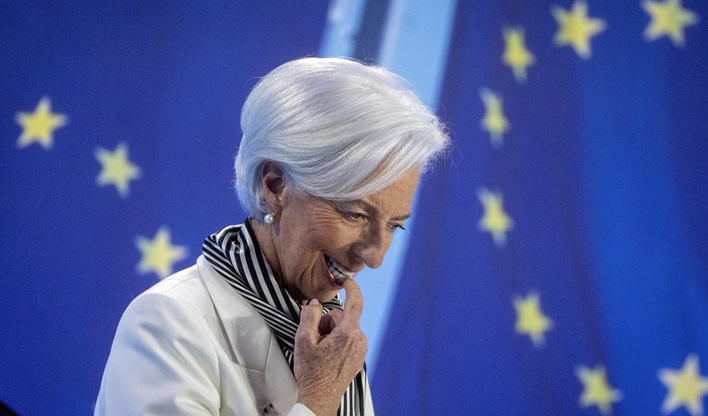
The European Central Bank cut interest rates on Thursday as widely expected, with the key deposit facility rate cut by 0.25 percentage points to 3.5%. Under a new regimen on spreads between the ECB's three rates, the main refinancing rate and marginal lending facility rate were each cut by 0.60 percentage points to 3.65% and 3.90% respectively.
The bank's decision was unanimous, President Christine Lagarde added in her press conference in Frankfurt.
In its meeting today, the ECB also slightly lowered its growth outlook, while keeping headline inflation guidance unchanged and raising its forecast for core inflation this year and next.
"Following the first cut in June, the ECB wisely gave it a couple of months to sit back and monitor the effects. Their view is clear, it's better to move slowly and steadily in one direction, rather than move too quickly and have to change course along the way," Morningstar strategist Michael Field commented, adding that economic data since June has validated this course of action.
"Inflation bumped around, but has ultimately fallen to a level very close to the central bank’s target, while economic growth has remained positive, but benign," Field added.
As the ECB announced in March this year, the rate on the main refinancing operations (MRO) will be adjusted such that the spread between the rates on the MRO and the deposit facility will be reduced to 15 basis points from the current spread of 50 basis points.
ECB president Christine Lagarde declined to detail the bank's future rate-cutting path, echoing previous statements that the ECB's governing council will follow a data-dependent, meeting-by-meeting approach.
Changes to the ECB's Key Interest Rates
As of September 18, the three ECB key interest rates will stand at:
-
Main refinancing rate: 3.65%, down by 0.60 percentage points from 4.25%
-
Interest rate for the marginal lending facility: 3.90%, down by 0.60 percentage points from 4.50%
-
Deposit facility rate: 3.50%, down from 3.75%
At present, the most important rate is the interest rate on the deposit facility, which defines the interest banks receive for depositing money with the central bank overnight. It is also the most important interest rate for savers as it has a direct impact on savings or checking accounts that accrue interest.
Market Reaction to ECB Rate Changes
European stocks were largely unchanged, as the moved had been expected. The euro rose by about 0.3% against the dollar.
This is the second interest rate cut for the deposit facility in five years, after June's initial cut, while the two other rates were last lowered in 2015. This follows 10 rate hikes since the Frankfurt-based institution began its rate hiking cycle in July 2022.
85% of economists polled by Reuters had expected the rate cut, and a vast majority is now looking at December for a third rate reduction of 0.25 percentage points this year.
Markets, meanwhile, were pricing in nearly four cuts in 2024 earlier this week, assigning some likelihood to an additional step in October.
ECB Trims Growth Outlook, Slightly Hikes Core Inflation Outlook
According to the latest Eurosystem staff projections, headline inflation average 2.5% in 2024, 2.2% in 2025 and 1.9% in 2026, as in the June projections. "Inflation is expected to rise again in the latter part of this year, partly because previous sharp falls in energy prices will drop out of the annual rates. Inflation should then decline towards our target over the second half of next year."
"For core inflation, the projections for 2024 and 2025 have been revised up slightly, as services inflation has been higher than expected. At the same time, staff continue to expect a rapid decline in core inflation, from 2.9% this year to 2.3% in 2025 and 2.0% in 2026," the statement added.
Previously, the ECB had forecast core inflation for 2024 and 2025 at 2.8% and 2.2%, respectively.
"Domestic inflation remains high as wages are still rising at an elevated pace. However, labour cost pressures are moderating, and profits are partially buffering the impact of higher wages on inflation. Financing conditions remain restrictive, and economic activity is still subdued, reflecting weak private consumption and investment."
ECB staff project that the economy will grow by 0.8% in 2024, rising to 1.3% in 2025 and 1.5% in 2026. This is a slight downward revision compared with June's projections for 0.9%, 1.4% and 1.6%, mainly owing to a weaker contribution from domestic demand over the next few quarters.
Fed Expected to Cut Rates Next Week
The ECB acted ahead of its US counterpart, which is expected to initiate rate cuts at its next meeting on September 17 & 18. “With inflation normalizing, there’s little reason to keep rates at highly restrictive levels, which risks triggering a recession,” says Preston Caldwell, chief US economist at Morningstar.
The Swiss National Bank was the first major bank to announce a rate cut in March, followed by Sweden's Riksbank in May. The Bank of England on the other hand was the last major European central bank to lower rates when it announced it would cut rates to 5% on August 1. Another BoE rate cut on September 20 would surprise markets.
How Far Will European Interest Rates Fall?
Morningstar's Field says: "The risk of the economy overheating because of further rate cuts appears low, suggesting that economists' expectations of one more rate cut before the end of the year is highly probable. The ECB's pattern of cut, monitor, and repeat is likely to continue."
Most analysts expect that the ECB will continue its rating cutting cycle in 2025 with three or more 0.25 percentage points reductions until September 2025. Fidelity expects three more quarterly cuts in 2025, bringing the interest rate down to a targeted 2.50% in September 2025, Carsten Roemheld of Fidelity said last week.
Analysts at DWS agree. In 2025, rates will fall by 0.25 percentage points each quarter until the target interest rate of 2.50% is reached in September 2025, Ulrike Kastens, European economist at DWS, forecasts. "The ECB Governing Council will definitely want to avoid lowering interest rates too quickly and thus accepting a renewed rise in inflation," she told Morningstar in an interview on September 5.
Bastian Freitag, head of fixed income Germany at Rothschild, also anticipates cuts of 0.25 percentage points each in September and December as well as further quarterly steps in 2025. Although inflation is likely to pick up again slightly at the end of the year due to base effects, the rate is gradually moving towards 2%, he said. Risks are posed by service price inflation, oil prices, a slight increase in money supply growth and wage trends, Freitag told Morningstar on September 5.
How Will Interest Rate Cuts Affect Markets?
Equity markets tend to rise on anticipated rate cuts. In bond markets, falling interest rates mean lower yields, which pushes bond prices higher. Lower rates also make existing bonds, and particularly those already issued during a period of high rates, more attractive for yields.
Meanwhile cash savings rates on bank accounts will likely decrease, to the detriment of savers. The rates that savers receive depend mostly on the deposit facility, which defines the interest banks receive for depositing money with the ECB overnight.
Borrowers, by contrast, stand to benefit from lower rates as consumer debt and mortgages become cheaper.
Analyst Reactions to Thursday's ECB Announcement
Frederik Ducrozet, Head of Macroeconomic Research, Pictet Wealth Management, on X:
“Revisions look dovish overall: small upward revision to core HICP due to sticky services inflation but no change to headline nor to the medium-term projections, while growth is revised lower throughout the forecast horizon. Not a pivot yet but the tide is shifting.”
Gurpreet Garewal, Macro Strategist Global Fixed Income, Goldman Sachs Asset Management, via email:
"Today's 0.25% cut in policy rates by the ECB was widely expected by market participants. With limited economic data expected by October's meeting, we do not foresee another cut until December, unless there is a significant deterioration in regional or global growth.
Looking further ahead, a faster easing cycle towards a lower terminal rate could occur earlier than current market pricing suggests. Over the summer, tourism, sporting events, and concerts boosted activity and inflation in the services sector, but both are expected to cool as the seasons change. Slowing wage growth has the potential to slow services inflation, which combined with growing downside growth risks, may prompt ECB officials to accelerate the pace of normalisation in 2025, compared to the quarterly pace adopted in 2024."
Ulrike Kastens, Economist Europe, DWS:
“Although there is still uncertainty about the further development of service prices, economic concerns are likely to increase further given the weakness of domestic demand. The risks to the economy were already assessed as being on the downside in July. The GDP forecasts for the years 2024 to 2026 have now also been revised downwards and the current economic situation has been assessed as worse than in July. The ECB continues to emphasise the high level of data dependency and ECB President Lagarde rejected any predetermination of an interest rate path. However, she also stated that a downward trend in interest rates was fairly obvious. Further interest rate cuts are therefore in the pipeline. December is likely to be the next date for a further rate cut. Overall, we expect the deposit rate to be at 2.50 per cent in 12 months' time.”
Des Lawrence, Senior Investment Strategist at State Street Global Advisors:
“As widely expected and priced by markets the ECB cut its deposit facility rate from 3.75% to 3.5% today. While the recent sharp fall in headline inflation across the Euro Area is very welcome, the concurrent rise in services inflation to 4.2% in August raises a dilemma for the ECB: how to avoid over-promising on policy moderation (there was arguably a hint of this in the run up to the June meeting ) and yet respond to legitimate concerns around a slowdown in activity that's gathering pace and breadth - even if not yet evident in labour markets. It will be particularly interesting to see what further insights President Lagarde can offer on this point at the press conference. We believe the rate of services inflation will ease thereby opening the door for further rate cuts in the coming months.”
Hussain Mehdi, Director, Investment Strategy, HSBC Asset Management, commented:
“A rate cut at this meeting wasn’t in doubt. Cooling economic data in the bloc – especially a big drop in wage growth – and a dramatic repricing of US rate expectations over the summer has weakened the hawks’ influence in our view.
“For the time being, we think the global economic outlook of further disinflation and central bank easing is a decent environment for risk assets and supportive of a further outperformance of stock markets outside the US, including Europe. This “broadening out” comes as the gap in profit growth between the US and other markets is expected to narrow, while valuations outside the US look undemanding, especially compared to the big tech names.
But the outlook remains highly uncertain. The risk of a hard landing remains fairly high as policy rates remain in restrictive territory. Market volatility is likely to be a key feature heading into 2025.”
Carsten Brzeski, Global Head of Macro, ING Bank, on his blog:
Looking ahead, we expect the ECB to eventually step up the pace of further rate cuts. Not this year, but next year. Why not this year? Because currently, German wage negotiations and increasing selling price expectations still point to some stickiness of inflation. And given that the ECB’s track record of predicting inflation on its way up is rather weak, the ECB will want to be entirely sure before engaging in more aggressive rate cuts.


























